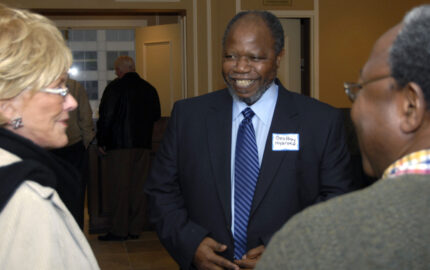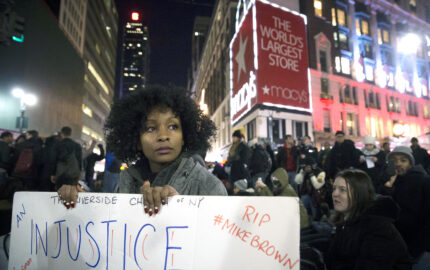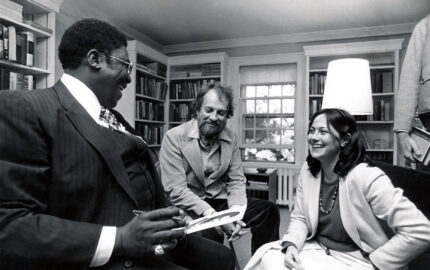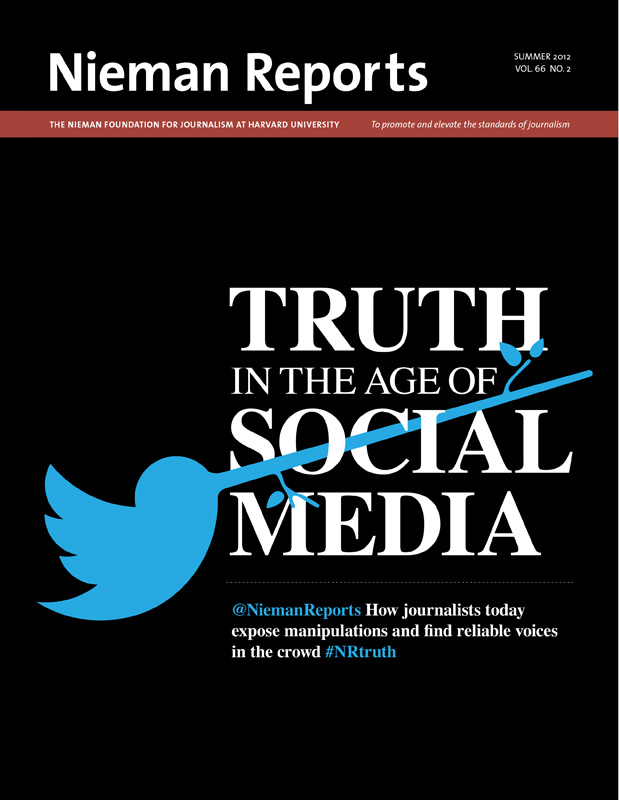
Truth in the Age of Social Media
Verifying information has always been central to the work of journalists. These days the task has taken on a new level of complexity due to the volume of videos, photos, and tweets that journalists face. It’s not only the volume that presents challenges but the sophisticated tools that make it easier than ever to manipulate information. This issue of Nieman Reports looks at how the BBC, the AP, CNN, and other news organizations are addressing questions of truth and verification.
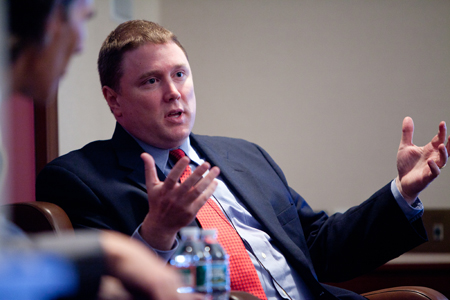
When J. Andrew Curliss investigated a district attorney, she attacked his work and his paper. Photo by Lisa Abitbol.
To say that the subject of reporter J. Andrew Curliss’s three-part series “Twisted Truth” was difficult is putting it mildly. Tracey Cline, the district attorney of Durham, North Carolina, repeatedly battled Curliss and his paper, The News & Observer in Raleigh, as he investigated actions and misstatements by Cline that had led to the dismissal of cases she had prosecuted.
After the series was published in September, Cline called it a “terrible injustice,” though she did not list any specific complaints. At Cline’s request, the paper published Curliss’s e-mail exchanges with her and audio of their interviews. She then held a public meeting in a locked courthouse to discuss the series. Finally, she filed a claim against a superior court judge, alleging that he had been behind the News & Observer’s series and that his rulings against her had been made for personal reasons. She subpoenaed Curliss and two of the paper’s editors for a hearing on the claim, which was ultimately dismissed.
In March, the Superior Court found that Cline’s actions had impaired her ability to seek justice and had brought her office into disrepute. She was removed as district attorney on the same day that Curliss was announced as the winner of the 2011 Taylor Family Award for Fairness in Newspapers for his work.
Taylor Award judge Tyler Bridges, NF ’12, said “what especially stood out for me was how the newspaper handled Cline’s attempts to discredit its work and that of its reporter ... The paper’s editors demonstrated considerable fairness when Cline cast the paper in the difficult role of having to report on her attacks against it.”
Nieman Reports’s Jonathan Seitz spoke with Curliss after the award ceremony:
Jonathan Seitz: Had it always been your goal to become an investigative reporter, or is that just where you wound up?
J. Andrew Curliss: Well, see, I don't like the phrase “investigative reporter.” That is my title, but I think most reporters are investigative reporters, and that's how I conducted myself on every beat. I would try to make an argument that the type of reporting that I like to do, which I think of as “revelatory reporting,” I've done my whole career. I joined our investigations team when a position opened up so that I could be focused solely on the revelatory part of things, and not as much on the nuts and bolts of beat reporting.
So the big advantage to being on the I-team is having the time and space to focus?
Yeah, you do have the opportunity to really dig in on a particular subject, in a way that perhaps you wouldn't, if you were covering a beat. But that’s not always the case at the N&O. If you’ve got a good story, then you can run with it.
Do you think you would have been able to do this “Twisted Truth” series, if you were still a city hall or court reporter?
It did take some time to put together, there's no doubt about that. But the type of story that I did is available to any reporter, on any newspaper, or any website—any medium. You do not have to be an “investigative reporter” to do this kind of work. What you do have to do is, you have to develop sources, and you have to have a mindset that, “There is information here that the public does not know about, and I'm going to try to help bring it to the public’s attention.” If you don't have the mindset, then you're never going to do these kinds of stories.
Is that a mindset you’ve had from your earliest days in reporting, or is it something that's developed over time?
I would say it’s probably something that I’ve had. It’s a part of me. I’ve always been, for lack of a better word, nosy. And I like to tell people things.
For “Twisted Truth” specifically, was it a document or something somebody said that got your interest up and made you think, “There's something here that people don't know”?
No, it was me sitting in the courtroom, paying attention. There was a hearing where the D.A. ended up on the stand and was asked a series of questions, and clearly did not handle the questions well. We were the only ones who covered that hearing, but on the same floor, basically across the hall, the news media for the entire region were covering a murder trial. If everybody else was sitting in the same courtroom, would they have seen what I did, and decided to go look? Who knows? But part of doing good work, in my view, is seeing things happen. It’s not just sources and records and all of that.
Why were you there in the first place?
I was covering the underlying case, working on the follow-up from a whole other series that we did on the State Bureau of Investigation here. I could have just wrote the story, “Oh, here’s the case, it got dismissed,” and then gone on. But as I was sitting there and seeing that, my mindset was, “God, there's more to this.” And the “more to it” was about the D.A.
And after that initial thought, when did you know for sure that it was going to be a big series?
That was December of 2010. I started sort of asking around in the beginning of 2011, and I did a fairly lengthy interview with the D.A. in July. It wasn't till after we talked to her that I knew, “Here is the shape of what we should be reporting.” But from December 2010 till July 2011, I was not focused only on that. At one point I did three weeks down at the legislature, and I covered a big football scandal at the University of North Carolina in Chapel Hill. I pull weekend shifts like everybody else—I cover the State Fair, or other things like that, you know? But, I would say probably May, June, July, August were pretty intense, probably three or four months of solid focus on “Twisted Truth.” And then the story ran in September.
It seemed like one of the noteworthy things about the story was you getting the D.A. involved early and letting her know what you were going to report beforehand. Is that always your tactic?
Yeah, on a story like that, I think it’s helpful to try to get to the focus of the story as early as possible—“as possible” being the key words. I mean, you have to know what you want to ask them. But part of being fair is giving the person a chance to properly explain themselves. This notion of just showing up at the courthouse on Friday before a story's going to run on Sunday and catching them where they can’t really explain their position—I just don’t think that's the right way to do it. I don't want to catch them, I want their best. And I want their best because that’s what gets you to the truth.
The last big series I did led directly to a felony for the governor, the firing of the chancellor at N.C. State, and the first lady of North Carolina being fired from her job at N.C. State. All of those were the same approach: Well in advance, want to hear your best.
So, at this point are people in Raleigh scared of getting a phone call from you?
Oh God no, I sure hope not! I wouldn’t want that.
Do you have any go-to techniques for your interviews?
When I'm interviewing somebody, I'm thinking about two things. One is, whatever I'm asking them about, how might I describe this in the paper? Because I think one of the traps that reporters can get into is they’re asking questions and asking questions, but then when they go to write the story they describe something one way and they don’t have the person directly responding to what they are reporting. Let’s say that I'm going to describe some fund as a slush fund, right? Well, if I'm going to write the words “slush fund” in the newspaper, I want to make sure that I say that in the interview. I want to ask them, “Is this a slush fund?”
The other is that I'm trying to listen. I think a lot of times we can just get so focused on, “I've got this list of questions I’ve got to get through, one to 10,” and you don't really listen to the answers. Maybe you’re on question three, and it could lead you in a whole new direction—if you were just listening. I tape a lot of my interviews and I go back and I’m listening to it and I think “Would you just shut up?” That’s one of the things that I’m really trying to do: ask short questions, and then be quiet.
And what’s your approach for getting public records?
We have a public records law in North Carolina, it’s not called freedom of information or FOIA or anything like that, but in general I make a lot of records requests, and study those records, and look for records that should have been provided but weren’t.
What do you do when you don’t get the records you should have?
Well, sometimes you write about it, sometimes you just go back to them and you point it out, and hopefully not often, but sometimes you sue them. In the [Governor Michael] Easley story, I wrote about a certain batch of records that were crucial to the story—travel records of the security detail that travels with the governor—and I had requested all of those, but the governor would not give them to us. We decided not to sue and waited until the next governor came in, who was running on a pledge of transparency and openness, and said, “Hey, we haven't been able to get all these, why don't you give them to us?”
So I got the records in this big jumbled-up batch, and when I put them all in order, lo and behold, there was no 2005 record in there. And of course that was the year I was interested in, and had been asking about, that related to the governor. We wrote about that, there was an investigation, committees, the whole thing, but they never did produce the records.
In a number of the “Twisted Truth” stories, there were a lot recreated crime scenes and investigations. Were those based on interviews with police and investigators, or just on court documents?
Both. Interviews, investigative documents, police documents, and—if was a trial—the transcript of the trial. There was one where we had a mountain of records that we had accumulated over the years about the case that we had never written about. The thing that was really interesting about that one—and about a lot of this—is that as a case goes up through the appeals, things can get distilled, and in the distillation, there can be distortion. What happens is, as these things go up, the one side is arguing their point really hard, and the other side is arguing their point really hard, and sometimes the Appeals, they just adopt one side of it. So as much as possible, I tried to rely on the documents closest to the ground.
In the first story of the series, the Court of Appeals made a decision and nobody really knew about it. What was really powerful about it was what the D.A. did after that, which was nothing. By the time I came onto it, well shoot, the Court of Appeals has already set this guy free. It took me about three months to find the guy, and just to figure out what was going on with it, and all of that, but at the end of the day, the power in that story was: nothing had been done, even after that. I really found myself trying to fact-check the Court of Appeals. Whatever I would report from the Court of Appeals, I would find that down in the actual trial transcript, and that sort of thing.
I got very lucky on that one because, when I went looking for the file, they said it had been thrown out after some records-retention period that had just passed. I said, “Well, do you have, like, a room that you put them in, or is there a dumpster somewhere? I’ll go look, I’ll look through it, just put me wherever it was last.” He says, “Well, I don’t want to do that. Let me look.” It was, like, a week later, he says, “You’re in luck, it was in the trash can. You can come get it.” So I went over to the Court of Appeals, to pick it up, and I’m walking out the door when the guy at the counter says, “Wait, wait, you can't take that, you need to make copies.” And I said, "Sir, this was in the trashcan. The clerk said I could come get it.” So I walked out of there with the only copy—it got literally rescued from the trashcan.
This is sort of a question that you haven’t asked but this is a court story, right? People think “Oh Wow! Jeez, this is all just sitting there in the court records.” I wish it were that easy. I mean, there’s no file somewhere where you say, “Oh, can I pull the file with the cases where the prosecutor's work was questioned?” There is no central file for that.
I've looked around, and I haven't found a lot of cases where it was one prosecutor, with misconduct in multiple cases. Usually you see prosecutorial misconduct by prosecutors X, Y, and Z, and it's all different prosecutors, right? It's a guy in Nashville did this, and a guy in Durham did that, and a lady in Fayetteville did this. It’s going to be that all these prosecutors have had cases overturned, but usually it's one case for each person. Or, you'll see big treatment of one case, with one prosecutor. That difference was what was unique about the DA. There's not a lot of examples of one prosecutor and multiple cases. There's one prosecutor, one case, written big — or there's multiple prosecutors, multiple cases, and that's more, “Oh, prosecutors mess things up.” But that was what was a little different about this.
It also made it challenging, because a lot of the most interesting ones are the ones that got dealt with in a plea, or an acquittal, or some kind of deal — and you never hear about it since there's no documentation, or there's no incentive for anybody to talk about it. You know, some guy got really screwed up, he got screwed over by the prosecutor—I'm just talking in general—so they just resolve it by some kind of a nice plea deal for them. I mean, that happens all the time.
